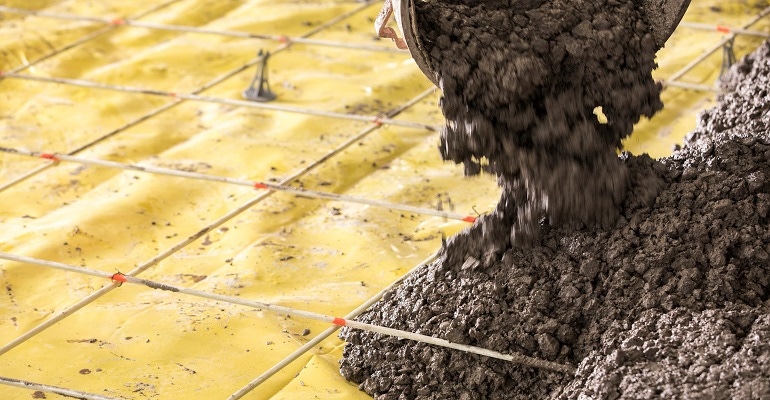As the price of steel goes up, rebar made from carbon, glass, and basalt fibers in a polymer matrix (FRP) becomes a good economical replacement for steel in the right applications, especially light slabs.
March 2, 2021

The downside of steel in concrete is that over time, moisture, chlorides, and oxygen penetrate the concrete and result in corrosion of the steel. This is especially a problem in structures that are exposed to deicing salts, like bridge decks or parking structures. To protect the steel, epoxy coated rebar was invented in the 1970s. Over the past 50 years, thousands of structures have been built using epoxy-coated bars and it has been mostly successful at extending the time until corrosion starts. Recently, however, some state DOTs have stopped specifying epoxy-coated rebar after finding many bridges where the coating had debonded from the steel. It only takes a small chip in the epoxy coating to allow corrosion to begin and spread beneath the epoxy coating.
There are some alternative concrete reinforcing materials that can be used to prevent corrosion. Stainless steel rebar is available but quite expensive and there is galvanized rebar, which has been around for many years but not widely used in the U.S. To learn more about galvanized rebar, click here. Another choice is materials that combine a polymer matrix with glass, carbon, or basalt fibers embedded—fiber reinforced polymer (FRP) rebars. These materials don’t corrode, they are much lighter than steel (about 1/6 the weight), they don’t get hot in the sun on the jobsite, and they are 4 times stronger in tension. And the newer bars have been designed with a gritty exterior so that they bond well to concrete.
There are some drawbacks, though, to FRP rebar. Glass fiber bars typically cost 15% to 25% more than the equivalent steel reinforcing, but with its higher strength less is needed. And with the rising price of steel rebar, that price differential is narrowing. And, there are some questions about how well FRP bars perform in a fire and some concern about its long-term deflection or creep. Another drawback is that the bars can’t be bent in the field but must be ordered bent from the factory.
For light reinforcing in flatwork, though, where the main purpose is crack control, glass FRP rebar is quite competitive, even on a first-cost basis, and since it is so much lighter than steel, it reduces labor cost. And with its high strength, less reinforcement is needed. There are a few companies making glass FRP rebar today. Owens Corning is promoting its Pinkbar (glass fiber in #2 through #5 sizes) and Neuvokas is manufacturing Gatorbar in Michigan. Gatorbar has both glass fiber and basalt fiber bars in #3 and #4 sizes. American Fiberglass Rebar and Dextra/Astec are other suppliers.

Buyer beware, though. Doug Gremel with Owens Corning, says, “It’s very easy to cut corners by using a less costly polyester resin that won’t be as durable in the alkalinity of concrete as bars made with better vinyl ester resins that have been shown to hold up in accelerated aging and real-time tests. There are lots of very inexpensive Chinese producers of glass fibers that sell at a fraction of the cost. This is a bit like the Chinese drywall problem, in my opinion, with some of these players.”
Concerning the use of carbon fiber in FRP rebar, Gremel says, “Carbon bar remains still in the exotic camp. It is clearly the best material and is used smartly and appropriately for structural strengthening of existing structures. Carbon FRP bars epoxied in shallow concrete grooves in the cover of structures, like a band-aid, give almost miraculous additional flexural and shear capacity to the member. However, carbon bars or carbon prestressing tendons remain at least 10 times more expensive than glass FRP bars and steel rebar.”
Perhaps the best solution for structural concrete that will be subjected to deicing salts may be hot-dipped galvanized rebar. Galvanized bars will resist corrosion for about 4 times longer than carbon steel bars and the price premium is only about 10%. Galvanized bars are readily available throughout the U.S. To learn more about epoxy-coated and galvanized rebar, watch this video from Professor Tyler Ley from Oklahoma State University. Or to see Tyler's video on FRP rebar, click here.
You May Also Like


